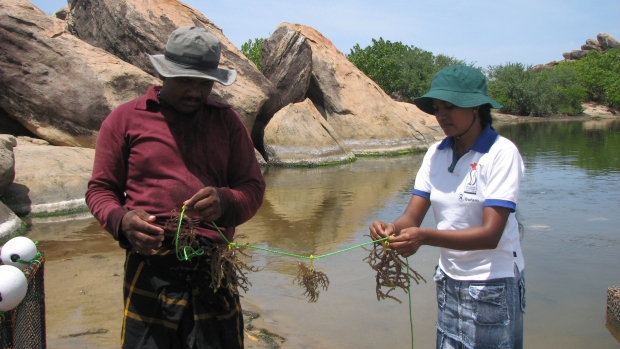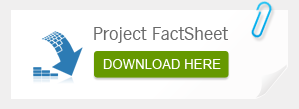Grants :: Small Grant Facilities :: Piloting seaweed farming as an alternative livelihood activity for coastal communities in Panama and Pottuvil
Piloting seaweed farming as an alternative livelihood activity for coastal communities in Panama and Pottuvil

Sea weed farming, Sri Lanka © RMahindapala , 2009
Objectives
The objectives of this project were:
- to raise the living standards of the coastal community;
- to promote sustainable use of marine and coastal resources; and
- to establish seaweed farming as an eco-friendly livelihood activity, especially for women, in the Pottuvil, Panama and Mawalla coastal area.
Background
Seaweed, apart from being a food, is an important source of colloids or gels such as agar, and medically important elements such as iodine. The seaweed Eucheuma sp. is a valuable source of carrageenan (polysaccharide gel), an important industrial compound used in stabilising and improving the quality of many food products. Many Sri Lankan confectionery manufacturers are interested in obtaining a local supply of carrageenan, so the demand for cultivated seaweed is expected to rise. Before this project, however, Sri Lanka had no organised seaweed cultivation.
The Sewalanka Foundation, a leading Sri Lankan NGO, secured a small grant from MFF to start a pilot seaweed culture initiative. This cultivated Eucheuma in offshore cages at Panama and Ullei (in Pottuvil) on Sri Lanka’s east coast. Sewalanka collaborated with two fisher cooperative societies in this project, the Abeysinghapura-Panama Fisheries Cooperative Society and the United Deep Sea Fisheries Cooperative Society in Pottuvil.
Several species of seaweed are commercially farmed in other Asian nations. In Sri Lanka, the Eastern and Southern provinces have good potential for seaweed cultivation, which also offers an alternative livelihood activity for poor coastal communities. The Sewalanka Foundation believes that women, in particular, could benefit socially and economically from the supplementary income provided by cultivating seaweed.
Target beneficiaries
Six fishermen, three from each fisher cooperative society, who showed a commitment to and interest in piloting seaweed culture.
Outputs
- Training of six fishermen in seaweed culture.
- Construction and offshore installation of 60 cages.
- Stocking of cages with seaweed cuttings.
- Completion of two culture cycles and harvesting of seaweed.
- Sun-drying and packaging of seaweed for the local market.
Accomplishments and challenges
As a result of this project, the participants enhanced their ability to diversify and supplement their livelihood. In two months, 100 g of cuttings grew into 1 kg (wet weight) of harvestable seaweed. About 50 kg to 70 kg (wet weight) of seaweed were harvested from a cage stocked with 4 kg of cuttings. (The dry weight of seaweed is about 10% to 12% of its wet weight.)
In Panama, the project secured a profitable contract with the National Aquatic Resources and Research Agency to supply mother plants to stock 100 cages in their Mannar project, under the Uthuru Wasanthaya Programme.
The project was supervised and monitored by the Sewalanka Foundation, which also provided relevant technology and assistance. Sewalanka is currently seeking partnerships to expand the project.
Challenges
The project encountered major difficulties, since there is no established market for seaweed in Sri Lanka, and finding a market for a small amount of dry seaweed is problematic as any buyers always want large quantities.
In the second culture cycle, the harvest from 56 cages had to be discarded after it was spoiled by heavy rain while drying.
Contributions to cross-cutting themes
Gender equality
Seaweed cultivation has the potential to provide jobs for women in coastal communities.
Lessons Learned
The pilot initiative proved that the seaweed Eucheuma sp. can be successfully cultured in the seas off Panama and Ullei, and that seaweed farming offers an alternative livelihood and a supplementary income.
Expanding the project should reduce the fishing pressure in Panama and Ullei.
An assessment is needed of the impacts of small-scale intensive aquaculture (cage culture) of the selected seaweed species as, in positive terms, a method for alleviating poverty and, in negative terms, an activity which may potentially damage the offshore environment.
Research is also needed to develop low-cost methods for seaweed farming, and to identify areas with no or small puffer and rabbit fish populations, as these fish browse seaweed crops, reducing their yield.
Seaweed is not widely consumed locally. As such, it is necessary to target the export market, which means large-scale production. An analysis of potential export markets should be the first step in planning and establishing an industry of this nature.
Project Facts
Country
Location
Panama, Sri Lanka
Topic
Duration
1st Jan 2009 to 30th Sep 2009
MFF Grant Amount
US$5,196
Implementing Partner
Sewalanka Foundation
432A, 2nd Floor, Colombo Road,
Boralasgamuwa,
Sri Lanka
Tel: +94 47 5675614
“This is one of the most successful projects I have ever been involved in, since I learnt a lot and gained extensive local knowledge, applying the lessons learnt to my current seaweed projects in Sri Lanka and finding success little by little.”
— MRS MAHEENI SINGAPPULI
NATIONAL FISHERIES COORDINATOR, SEWALANKA FOUNDATION
